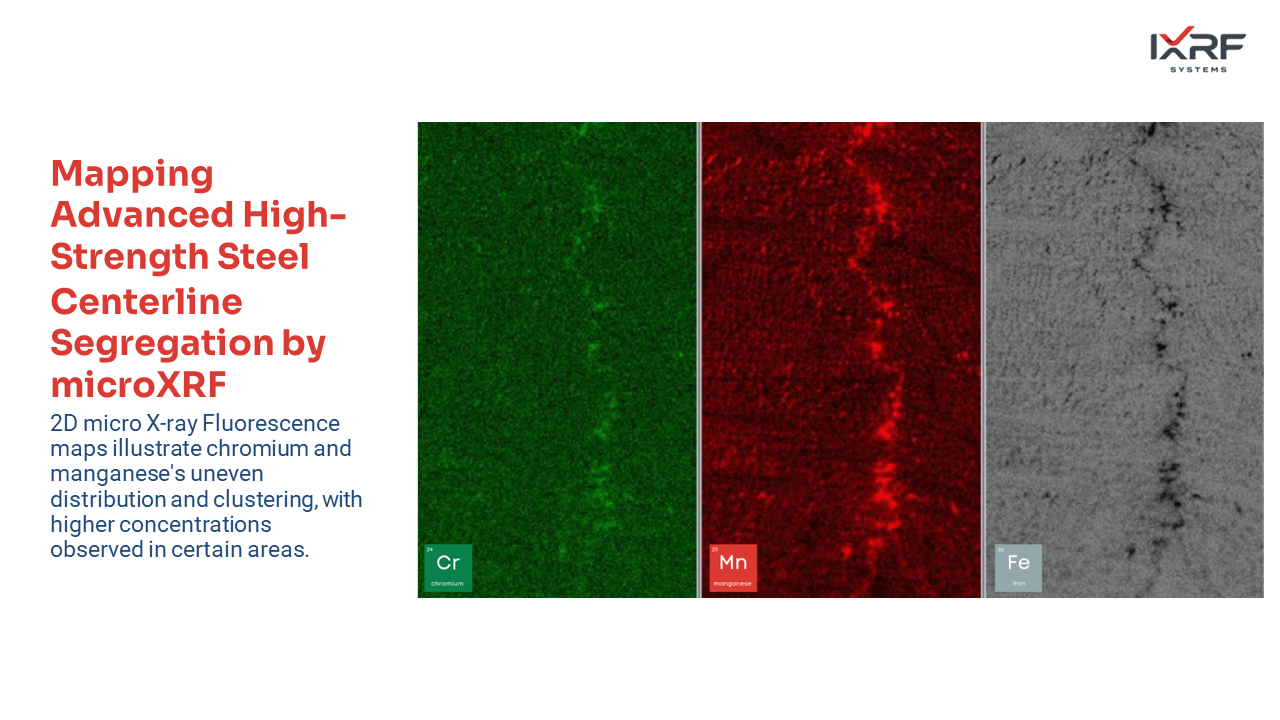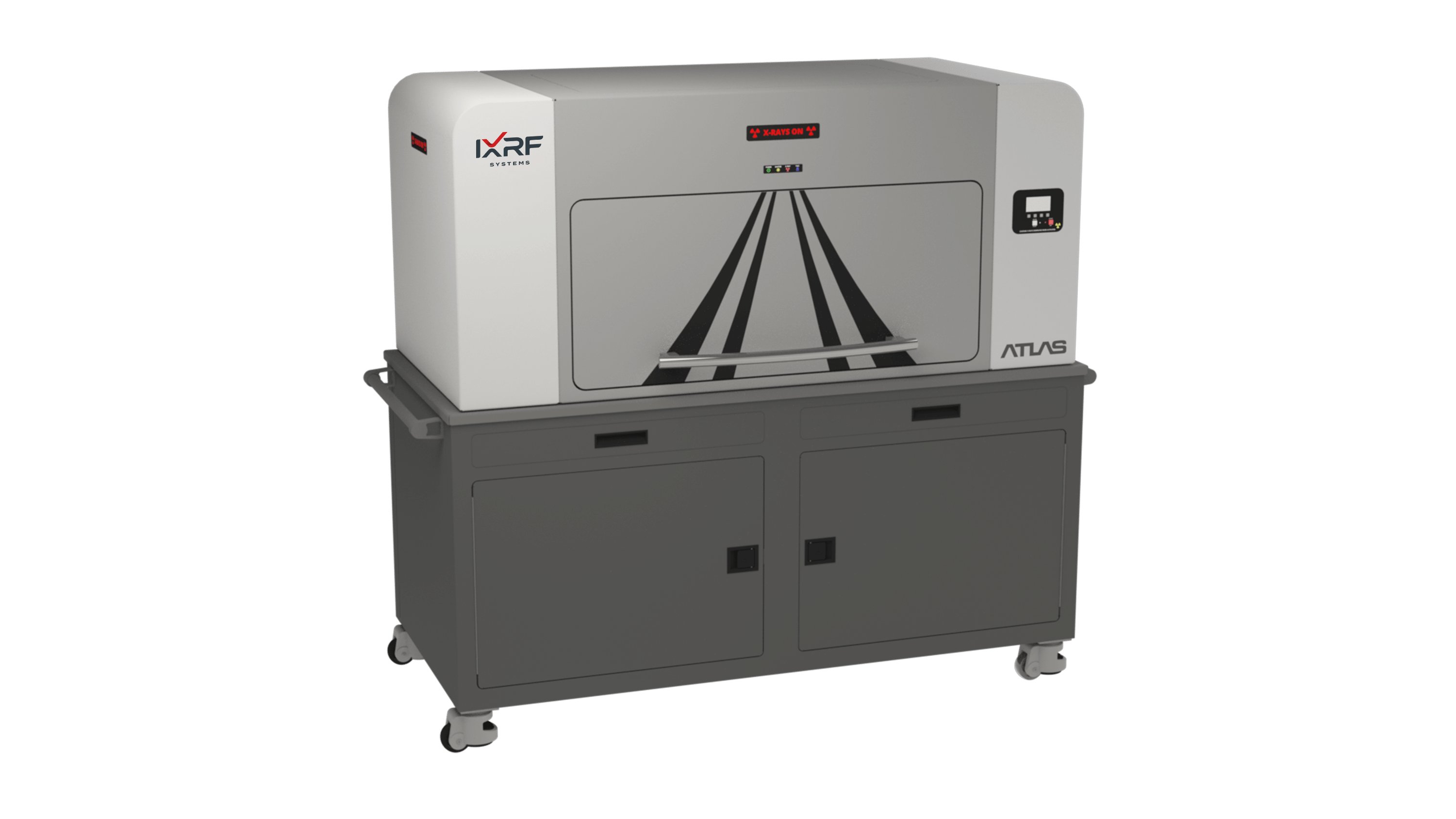Industrial reliance on Advanced and Ultra High Strength Steels (AHSS and UHSS) is due primarily to the remarkable mechanical properties of these materials. However, these high alloy content steels often experience element segregation along the centerline of the material during the continuous casting process, affecting the quality of slabs and their mechanical properties. Quality is a defining consideration in any industry; and, in the steel industry, the challenge lies in identifying, quantifying, and minimizing this segregation to ensure consistent product quality. The current method for monitoring slab quality is a deep etching method, primarily a qualitative process that is long, labor intensive, subjective and inconsistent. Therefore, the industry needs a solution that offers objective, repeatable, standardized, and quantitative results across different manufacturing units. An analytical tool that can achieve this solution is micro-X-ray Fluorescence (µXRF) technology as offered by IXRF Systems.
Current steel slab monitoring limitations and their cost impact
The prevalent method of slab quality monitoring in steel production is through metallographic evaluation, which is the study of the microstructure of metals and alloys. This evaluation involves the preparation, examination, and analysis of metal samples to understand their internal structure, grain size, phases, inclusions, and other important features. Metallography is essential for understanding the properties and behavior of metals, including their mechanical, thermal, and electrical properties.
The process typically involves several steps:
Sample Preparation: A small piece of the metal or alloy is carefully cut, mounted, and polished to create a flat surface. This preparation is crucial to ensure accurate microscopic examination.
Etching: The polished surface may be chemically etched to reveal the microstructural details. Different etchants are used for specific metal types to highlight various features of the grain structure.
Microscopy: The prepared sample is then examined under a microscope, usually an optical or scanning electron microscope (SEM), at various magnifications. This allows scientists/engineers to observe the grain structure, phases, defects, and other characteristics of the metal.
Analysis: The observed microstructure is analyzed to understand how it affects the material’s properties, such as strength, ductility, hardness, and corrosion resistance. This information is essential for materials scientists, engineers, and metallurgists to design and improve materials for various applications.
Metallographic examination of steel slabs can be a laborious process and be qualitative and subjective in nature, which can introduce variability in results across different manufacturers and even from one operator to the next within the same plant of a given manufacturer. These inconsistencies can lead to errors in steel grading, impacting the quality score of the end product, potentially damaging customer trust and future sales. Enormous expenses are incurred when steel slabs need to be shipped back to the original manufacturer due to poor slab scoring, not to mention the impact this has on the environment.
Micro-XRF as a component of the Green Steel future: enhancing quality, lowering costs, and reducing emissions
Micro XRF technology offers a distinct advantage in overcoming the challenges associated with the current method for steel slab grading. Micro XRF leverages X-rays to excite the surface of a sample, allowing for the identification and precise location of different elements with very high spatial resolution (down to 5µm pixel diameter). The technology can elementally map a slab’s centerline to spatially locate the elements present, such as manganese and sulfur, that typically segregate along the centerline.
By analyzing how certain alloy elements are spatially segregated (what elements and where are they) and at what concentration these elements are present throughout this segregation, one can develop a scoring algorithm that relies on precise, quantitative input data (as generated by micro XRF) eliminating all subjectivity.

Figure 1: Steel slab sample elementally mapped utilizing IXRF System’s Atlas µXRF collected with a spot size of 40µm.
Moreover, these elemental maps can detect potential production issues, such as material impurities or inclusions. With appropriate software, these inclusions can be automatically identified and measured, potentially allowing process adjustments to eliminate these problems.
All these benefits result in significant cost savings and overall reduced emissions due to fast, accurate slab scoring and process adjustments that are more in-line with production. Micro-XRF’s accuracy reduces waste caused by problematic segregation and improves product quality, enhancing customer satisfaction, increasing sales and lowering emissions.
IXRF System’s ATLAS µXRF solution: a smart investment
IXRF System’s ATLAS µXRF instrument is a powerful solution delivering precise elemental analysis and can serve to objectively score the quality of centerline segregation in steel slab production. The ATLAS boasts the largest chamber and fastest sample stage available, accompanied by the most advanced software to meet diverse analytical needs.
Figure 2: Atlas X microXRF spectrometer with large chamber size and 300(X) x 400(Y) mm mapping travel.
As a significant upgrade from etching-based imaging, µXRF is an analytical and fully quantitative method. It can accurately determine the product’s chemistry and precise location of various elements, significantly enhancing the grading and potential control of alloy segregation during continuous casting processes, ultimately minimizing waste and emissions as part of the Green Steel initiative.
Conclusion
Investing in tools like the ATLAS µXRF offers both qualitative and quantitative results and delivers significant returns by improving quality assurance in AHSS and UHSS production. By providing accurate and detailed analysis, µXRF ensures higher product quality and consistency, thereby enhancing customer trust and sales, contributing to a robust ROI and waste reduction. As innovations continue to evolve in materials science, technologies like µXRF will play an increasingly vital role in setting industry standards and shaping the production of high-performance materials for the future.
IXRF Systems is a leading provider of X-ray fluorescence instrumentation. With our advanced analytical solutions, we are committed to supporting research, quality control, and educational endeavors across various industries.


